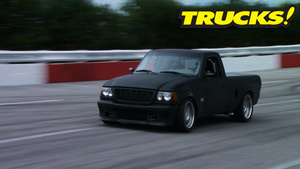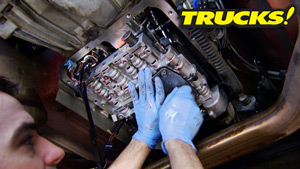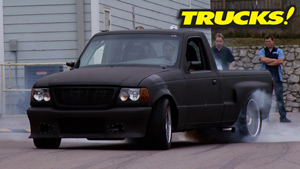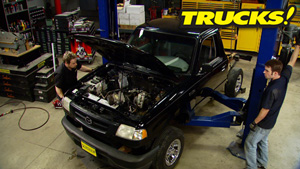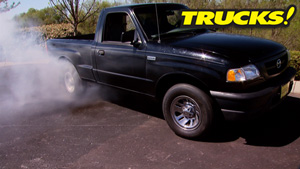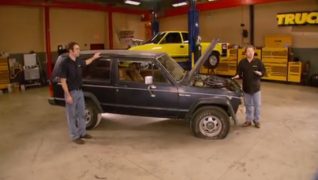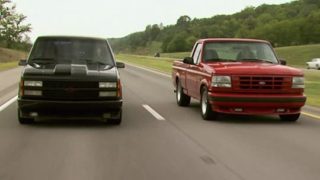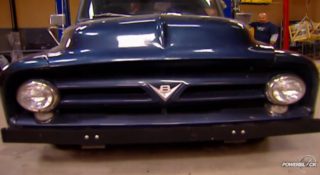More '01 Mazda B2500/Ford Ranger "Rolling Thunder" Episodes
More Rolling Thunder Episodes
Trucks! Builds
Want more content like this?
Join the PowerNation Email NewsletterParts Used In This Episode
Ford Performance Parts
Ford Racing 2003-04 Mustang Cobra Upgraded Whipple Supercharger Kit
Baumann Electronic Controls, LLC
Baumannator TCS Stand-Alone Transmission Controller
Coker Tire
Distributor of Vintage Tires and Wheels for Classic Cars and Trucks
Tremec
Tremec T56 MAGNUM 6-speed
Episode Transcript
Today, we're hitting the streets with Project Rolling Thunder. Our 4.6 L powered Ford Ranger based compact pickup to see just how our new drive train motivates this mini lightning. It's all today here on trucks.
Hey guys, welcome to trucks. Well, today is kind of a special episode for me. This marks my 1/100 episode of trucks TV. So it's only fitting. We're working on an awesome project. This is Rolling Thunder, our va converted compact truck. It's a Mazda B 2500 or started out that way, but we're calling it a ranger too since essentially it's the same vehicle. And obviously there's been a ton of work done so far. So we're gonna give you a little recap and catch you up on what's been done
after yanking the original four cylinder, the Marauder 46 in transmission went in without a whole lot of trouble. We rearranged some stuff under the hood, built a new exhaust system and boy, it sounded great.
Now, here's a couple of the things that you haven't seen a stoop. We actually bought a V8 Explorer radiator, but the core size was identical to the original four cylinder radiator, so we sent it back, saved some money and we're repurposing this one.
Now, obviously, we've lost the mechanical fan from the four cylinder with the 46. So we went to Summit racing and purchased a 17 inch puller that should be pretty good and pretty efficient
on the radiator hoses. Again, we went to the parts store and pieced some stuff together that is going to complete the cooling cycle.
The upper hose is a stock one. So again, we save money there and we're kind of betting that between the efficiency of the cooling fan, all the space we've got between the fan and the engine as well as believe it or not, there's still some pretty good room underneath the hood despite this being a compact truck. So all told this should be pretty efficient in the cooling department.
Now, based on the discoloration of the stainless steel exhaust tubing and catalytic converters, it's pretty apparent we've been running our 46 in the shop quite a bit
now before we run it anymore. And certainly before we drop the body back down on this thing, we gotta do something to isolate the heat that the exhaust tubing and cats make from any non metal object like the wiring harness, sensors and switches on the transmission as well as the transmission shifter cable.
Now, catal
converters can operate in a heat range of 1200 to 1600 degrees. That's why the O Ems take so much care to insulate the areas around them
and with our sitting right next to the transmission and the transmission cooler lines, well, we don't want to heat up the transmission fluid any more than we have to.
So to get that done, we're going to use a combination of simple aluminum heat shields and some exhaust heat insulation products.
Now, installing the exhaust wrap is pretty straightforward,
but you are going to need some stainless steel zip ties or retaining straps to hold it in place.
Now to hold the heat shields in place just using a couple of self tapping screws.
Now, the thermal protective wrap we put over the exhaust tubing and secured with stainless steel zip ties came from Taylor
and they also make this thermal protective sleeve that's good for up to 1200
°F.
So we're gonna put a section of this over top of our plastic coated B and M shift cable. Last thing we need is that outer plastic layer melting.
Now, we know our shifter cable was built to withstand some heat,
but our 46 is going to make plenty of it. So we're installing this just to be on the safe side,
all with our heat issue resolved. We can move on to one of the last pieces of our little stage one puzzle here and that's getting the automatic transmission operational. And when this engine and transmission combo sat down in between the frame rails of the 03 marauder that it came out of. Well, they were both electronically controlled by the same
computer, the PC M or power train control module. And since we've got our dual overhead cam 46 running on a stand alone engine management system, we need to do something similar for the transmission as well since it's also electronically controlled. So we picked up a stand alone harness and a stand alone computer for it as well.
Now, the wiring harness plugs directly into a few key sensors on the side of the transmission,
it also allows you to wire in a neutral safety switch right into your start circuit.
Now, the other end of the harness, one piece plugs right into the computer and you've got a handful of other connections to make for throttle position sensor, RPM, input a couple of power and ground hookups along with a couple of other connections
and with the dominator transmission control system, you can even set your truck up to have two separate transmission files or calibrations say you want to set it up to have normal everyday street driving characteristics and you want to be able to flip a switch and go to a more aggressive shift pattern to match your more aggressive driving. Well, you can do that
or say you got a street strip vehicle that's maybe spraying nitrous and you want to be able to load a more aggressive or race type transmission calibration when you activate the nitrous. Well, you can set it up for that as well,
but you can do, like we're gonna do keep it really simple and run a single tune. But there are a couple of changes we need to make to the software before we load it up.
Now, the dominator software, it comes preloaded with a few different calibrations. We've chosen a four valve cobra file because it'll pretty closely match what we want out of our ranger.
The problem is the cobra has about a 500 RPM red line advantage over our Marauder engine.
So we're just gonna go in here, lower the shift points across the board. So they're just underneath our 6100 RPM red line,
save our progress.
We can upload this file into our computer,
but it's so easy even I can do it.
All right. Once we get this wire and harness installed power and ground hooked up and everything plugged in and connected to the computer, we can upload the file from the laptop, we should be up and running.
Now, installation is really straightforward
with the harness, utilizing factory style connectors, plugging right into the Ford sensors on the transmission.
Now, it would be nice if we could remove the transmission portion from the rest of the wiring harness. But we've got things like the 02 sensor hookups that are tied into it.
I guess we could cut the loom open and separate the wires we need from the ones we don't,
but it's just not worth the hassle. Like we've told you plenty of times before this automatic transmission is going away when we go to stage two. So, what we're gonna do is bundle up and tie off the connectors we're not using. You can finish installing the stand alone harness. We'll be in good shape
up next. It's go time for project rolling thunder
and later it's bigger caliber, go fast. Goodies for rolling thunder. Stay tuned.
Hey, welcome back to trucks. Well, project rolling thunder is all bolted back together and up and running. We're ready to put some test miles on this thing.
From the first moment we hit the road, rolling thunder sounded and felt really strong
and as fun as it was driving the ultimate sleeper, the stock suspension kind of started to show us some problems that we already knew we had,
but horsepower wasn't one of them. Unlike when we first got the truck.
Now there's all this truck in handle. And then some,
and after putting a few miles on the truck, we noticed a less than healthy noise coming from under the hood
that rattle. If you can hear it more
and very light throttle, almost just a
I
that you can
under
heard it. Then
I
think our screaming deal engine wasn't so much of a screaming deal.
Now, we knew we had a slightly wounded engine but it was really tough to resist the temptation of our newfound 300 horsepower
and just cruising around, we didn't have any engine noise whatsoever and the gauges look great. Heck, even our stock four
cylinder radiator kept our V8 nice and cool all day long. Never getting above 200 degrees with the help of the electric fan.
But the engine noise was still there and we knew we were pushing our luck.
So we reluctantly headed back to the shop.
Yeah. Yeah.
Wow, that is definitely what we're hearing inside the cab. And if I was a betting man, I'd say that's a connecting rod getting ready to let go. But you know, that's ok because we got a screaming deal on this engine. The guy that sold it to us was a salvage yard and he even said it was from a theft recovery vehicle. So even if we did have to spend the coin to rebuild this, we'd still be all right at it. But, you know, the real reason to stick this engine in here was to make sure that it fit and get this truck ready for the next step.
Yeah. And with that accomplished and the engine a little bit injured. Well, I guess we have no
choice but to move right into stage two, which we've been anxious to do anyway. So no big deal. Now, we definitely got some drive train upgrades we're gonna make along with some unique suspension modifications that are a little bit outside of the box. Now, as far as the original Marauder engine is concerned, well, we'll yank it out, set it off in the corner and let it collect dust or maybe ship it off to horsepower. See what they can do with it. Either way we've got some serious hardware to replace that thing
and at least we got to put a few miles on this truck. Let's get it inside.
It looks good.
Yeah, I hope the new one fits too
up next. Like Ryan said, we've got serious hardware and later we're given this classic 37 Ford. It's vintage look back, stick around.
But Linda,
hey, guys, welcome back to the shop.
Well, since the beginning of this project, we've been chomping at the bit to get right to stage two
and, well, there's no better time than right now.
But before we started tearing this truck apart again, we wanted to throw it on the scales and see what our weight bias was front to rear as well as how much weight we've actually added by swapping to a V8.
And it looks like we've got some pretty good news as far as overall weight and weight bias is concerned. Especially considering that our V8 and automatic combination weighed 200 pounds more than the Anemic four cylinder five speed combo that came in our little Mazda Ranger. Now, originally, our truck weighed in at 3090 pounds, but the scale shows we're
now weighing in at 3125 meaning we only picked up 35 pounds overall and even better yet. Well, our weight bias is still at 62%
and that tells us all the effort we put into setting the engine back as far as possible, doing a slight relief to the firewall and all the other little things we did to either remove weight altogether or locate
weight farther to the back of the truck has paid off and it's got us on the right track to getting closer to that ideal 5050 weight split front to rear for stage two of this build.
Now, you heard Ryan, right. We've switched to a V8, a 200 pound heavier V8, but our vehicle weight is still almost the same where that 165 pounds go check this out,
the rubber mat
liners exhaust system, the condenser, the AC system, all of this stuff seriously contributes to a lot of weight loss. And we haven't even gotten serious about weight reduction yet. But there's another great way that we can reduce weight and increase efficiency. And that is by switching from an automatic transmission to a manual.
Yeah, because with the convenience of an automatic comes a weight penalty. Not to mention they're just not as efficient at transferring power as a manual gearbox. That's why we're going with this T Tr
magnum T 56. Now, this is a new six speed transmission from TRM
and there's lots of cool stuff to talk about, but we'll get to the details later for. Now, I will tell you this thing will handle 700 ft pounds of torque, which makes it a perfect match for our engine.
Now, to connect it to the engine, we're using this lightweight steel SF I certified bell housing from quick time. Now due to its compact design, it maximizes header and transmission tunnel clearance.
Now, a lot of guys just reach for an aluminum Bell housing, but we're gonna be making a lot of power. We're not gonna be easy on the truck so to play it safe, we went this route. Speaking of lots of power
check this out
now, just like our Marauder engine. This bad boy is a 4.6 L, dual overhead cam V8 out of the Ford racing catalog, you guys might know it better as the illuminator. Now, it's based off of the legendary and nearly bulletproof 03 and 04 Mustang Cobra Terminator engines that were capable of producing
and withstanding gobs and gobs of power.
Now, one of the things that makes this one different and where it got its name is, this one has an aluminum block saving us some weight. Now, the illuminator comes in two different versions, a high and low compression, either 10 to 1 or 8.5 to 1. We went with the low compression because we're gonna be running forced induction and lots of it.
Now, one of the best parts about this engine,
it's got brand new rod bearings.
Now, you Cobra guys know that the stock terminators came with the Eaton M 112 root style supercharger, not a bad piece of gear, but this,
it is an awesome upgrade.
This is the whipple Ford racing
2.3 root style supercharger. Now just bolting this on a stock terminator is gonna get you an additional 85 horsepower at the wheels. And one of the cool things about the whipple is that the front pulley is interchangeable with this 3.5 inch pulley. It's gonna get us somewhere around 13 pounds a boost. But the good thing is if you wanna make more boost, it's as simple as reducing the pulley size. Now, this combination on Von Gittens Drift car netted him about 680 horsepower and 600 ft pounds of torque at the rear wheels. Now, do we need that with a 3000 pound Ford Ranger? I don't think so, but it's sure fun to know that we can get there pretty easy.
You're watching trucks for a DVD copy of this episode. Just go to Power Block tv.com and order your copy for just 595 plus shipping and handling. Start your own trucks collection delivered right to your door from the power block.
Welcome back to trucks.
We'll check this classic out. This truck is on loan to us from the folks at Coker tire. And if it looks a little bit familiar to you, well, maybe this much of the roof in the windshield. If you remember a couple of seasons ago, our project H RT our 37 Ford Street Rod truck with the Molts for the fiberglass were actually pulled off of one of these, an actual 1937 Ford truck.
Now, this truck is kind of an interesting mix of the options that were given to the standard and deluxe cabs and it's obviously been gone through once and it's showing its age in a couple of different places.
Now, all 37 Fords came with a cool flathead V8, but there were two different versions, a tiny little 2.2 L, 136 cubic inch version putting out 60 horsepower and the more commonly optioned 221 cubic inch or 3.6 L V8 putting out 85 horsepower. Now, this is a later version of the 221 with the 24 studs
holding down the often house
or cylinder head. In addition to the upgraded head, it's also got a cast Fenton manifold and a 12 volt conversion making for a nice reliable driver.
Now, as cool as this old truck is, the paint is not the only thing showing its age, check out these old bias ply tires, there's tons of tread, but look at the cracks in the side wall and just in case the camera doesn't show it up enough. Look at this.
Now, on top of being dry, rotted, old and cracked, these are bias ply tires which haven't been standard issue on passenger cars and trucks since the early seventies. So safe to say it's time for an upgrade because these are probably not the safest things that you could have on a vehicle.
Now, older bias ply tires like the ones found on this truck are constructed by laying out the plies at a 45 degree angle from the center line of the tire
that resulted in a stiff
side wall, increased rolling resistance and a harsher ride. For the next evolution in tires, manufacturers added fiberglass reinforced belts to the bias ply tires. These became popular in the late sixties on muscle cars due to the wider footprint.
Now, the Coker radial tires that we're upgrading to look just like original replacements, but they utilize a far superior modern design and construction. A radial tire simply means that the overlap plies are laid at a 90 degree angle from the center line of the tire followed by steel belts. This produces a more flexible tire that handles better and offers less rolling resistance. So along with the better construction of a radio, you also get the cool vintage look with the wide whites and by the way, the white wall tires and red lines that Coker manufactures well. It's not just an afterthought, the white walls and red lines are actually a part of the construction of the tire. So there are no safety issues there.
Now, we've heard horror stories about how some people try to achieve the look of a white wall. Evidently, some people try to grind out the side wall and glue in a white wall after the fact
or even taking a white raised letter tire and grinding down to the black layer on top to get to the white layer of rubber underneath, then polishing it to make it look good.
Either method will compromise the safety of the tire.
So thanks to Coker tire, you've got safe and affordable options that lend a fantastic look to any classic vehicle and an upgrade that is going to ensure that a truck like this spends a lot more time exactly where it belongs that's out on the road starting now.
Show Full Transcript
Hey guys, welcome to trucks. Well, today is kind of a special episode for me. This marks my 1/100 episode of trucks TV. So it's only fitting. We're working on an awesome project. This is Rolling Thunder, our va converted compact truck. It's a Mazda B 2500 or started out that way, but we're calling it a ranger too since essentially it's the same vehicle. And obviously there's been a ton of work done so far. So we're gonna give you a little recap and catch you up on what's been done
after yanking the original four cylinder, the Marauder 46 in transmission went in without a whole lot of trouble. We rearranged some stuff under the hood, built a new exhaust system and boy, it sounded great.
Now, here's a couple of the things that you haven't seen a stoop. We actually bought a V8 Explorer radiator, but the core size was identical to the original four cylinder radiator, so we sent it back, saved some money and we're repurposing this one.
Now, obviously, we've lost the mechanical fan from the four cylinder with the 46. So we went to Summit racing and purchased a 17 inch puller that should be pretty good and pretty efficient
on the radiator hoses. Again, we went to the parts store and pieced some stuff together that is going to complete the cooling cycle.
The upper hose is a stock one. So again, we save money there and we're kind of betting that between the efficiency of the cooling fan, all the space we've got between the fan and the engine as well as believe it or not, there's still some pretty good room underneath the hood despite this being a compact truck. So all told this should be pretty efficient in the cooling department.
Now, based on the discoloration of the stainless steel exhaust tubing and catalytic converters, it's pretty apparent we've been running our 46 in the shop quite a bit
now before we run it anymore. And certainly before we drop the body back down on this thing, we gotta do something to isolate the heat that the exhaust tubing and cats make from any non metal object like the wiring harness, sensors and switches on the transmission as well as the transmission shifter cable.
Now, catal
converters can operate in a heat range of 1200 to 1600 degrees. That's why the O Ems take so much care to insulate the areas around them
and with our sitting right next to the transmission and the transmission cooler lines, well, we don't want to heat up the transmission fluid any more than we have to.
So to get that done, we're going to use a combination of simple aluminum heat shields and some exhaust heat insulation products.
Now, installing the exhaust wrap is pretty straightforward,
but you are going to need some stainless steel zip ties or retaining straps to hold it in place.
Now to hold the heat shields in place just using a couple of self tapping screws.
Now, the thermal protective wrap we put over the exhaust tubing and secured with stainless steel zip ties came from Taylor
and they also make this thermal protective sleeve that's good for up to 1200
°F.
So we're gonna put a section of this over top of our plastic coated B and M shift cable. Last thing we need is that outer plastic layer melting.
Now, we know our shifter cable was built to withstand some heat,
but our 46 is going to make plenty of it. So we're installing this just to be on the safe side,
all with our heat issue resolved. We can move on to one of the last pieces of our little stage one puzzle here and that's getting the automatic transmission operational. And when this engine and transmission combo sat down in between the frame rails of the 03 marauder that it came out of. Well, they were both electronically controlled by the same
computer, the PC M or power train control module. And since we've got our dual overhead cam 46 running on a stand alone engine management system, we need to do something similar for the transmission as well since it's also electronically controlled. So we picked up a stand alone harness and a stand alone computer for it as well.
Now, the wiring harness plugs directly into a few key sensors on the side of the transmission,
it also allows you to wire in a neutral safety switch right into your start circuit.
Now, the other end of the harness, one piece plugs right into the computer and you've got a handful of other connections to make for throttle position sensor, RPM, input a couple of power and ground hookups along with a couple of other connections
and with the dominator transmission control system, you can even set your truck up to have two separate transmission files or calibrations say you want to set it up to have normal everyday street driving characteristics and you want to be able to flip a switch and go to a more aggressive shift pattern to match your more aggressive driving. Well, you can do that
or say you got a street strip vehicle that's maybe spraying nitrous and you want to be able to load a more aggressive or race type transmission calibration when you activate the nitrous. Well, you can set it up for that as well,
but you can do, like we're gonna do keep it really simple and run a single tune. But there are a couple of changes we need to make to the software before we load it up.
Now, the dominator software, it comes preloaded with a few different calibrations. We've chosen a four valve cobra file because it'll pretty closely match what we want out of our ranger.
The problem is the cobra has about a 500 RPM red line advantage over our Marauder engine.
So we're just gonna go in here, lower the shift points across the board. So they're just underneath our 6100 RPM red line,
save our progress.
We can upload this file into our computer,
but it's so easy even I can do it.
All right. Once we get this wire and harness installed power and ground hooked up and everything plugged in and connected to the computer, we can upload the file from the laptop, we should be up and running.
Now, installation is really straightforward
with the harness, utilizing factory style connectors, plugging right into the Ford sensors on the transmission.
Now, it would be nice if we could remove the transmission portion from the rest of the wiring harness. But we've got things like the 02 sensor hookups that are tied into it.
I guess we could cut the loom open and separate the wires we need from the ones we don't,
but it's just not worth the hassle. Like we've told you plenty of times before this automatic transmission is going away when we go to stage two. So, what we're gonna do is bundle up and tie off the connectors we're not using. You can finish installing the stand alone harness. We'll be in good shape
up next. It's go time for project rolling thunder
and later it's bigger caliber, go fast. Goodies for rolling thunder. Stay tuned.
Hey, welcome back to trucks. Well, project rolling thunder is all bolted back together and up and running. We're ready to put some test miles on this thing.
From the first moment we hit the road, rolling thunder sounded and felt really strong
and as fun as it was driving the ultimate sleeper, the stock suspension kind of started to show us some problems that we already knew we had,
but horsepower wasn't one of them. Unlike when we first got the truck.
Now there's all this truck in handle. And then some,
and after putting a few miles on the truck, we noticed a less than healthy noise coming from under the hood
that rattle. If you can hear it more
and very light throttle, almost just a
I
that you can
under
heard it. Then
I
think our screaming deal engine wasn't so much of a screaming deal.
Now, we knew we had a slightly wounded engine but it was really tough to resist the temptation of our newfound 300 horsepower
and just cruising around, we didn't have any engine noise whatsoever and the gauges look great. Heck, even our stock four
cylinder radiator kept our V8 nice and cool all day long. Never getting above 200 degrees with the help of the electric fan.
But the engine noise was still there and we knew we were pushing our luck.
So we reluctantly headed back to the shop.
Yeah. Yeah.
Wow, that is definitely what we're hearing inside the cab. And if I was a betting man, I'd say that's a connecting rod getting ready to let go. But you know, that's ok because we got a screaming deal on this engine. The guy that sold it to us was a salvage yard and he even said it was from a theft recovery vehicle. So even if we did have to spend the coin to rebuild this, we'd still be all right at it. But, you know, the real reason to stick this engine in here was to make sure that it fit and get this truck ready for the next step.
Yeah. And with that accomplished and the engine a little bit injured. Well, I guess we have no
choice but to move right into stage two, which we've been anxious to do anyway. So no big deal. Now, we definitely got some drive train upgrades we're gonna make along with some unique suspension modifications that are a little bit outside of the box. Now, as far as the original Marauder engine is concerned, well, we'll yank it out, set it off in the corner and let it collect dust or maybe ship it off to horsepower. See what they can do with it. Either way we've got some serious hardware to replace that thing
and at least we got to put a few miles on this truck. Let's get it inside.
It looks good.
Yeah, I hope the new one fits too
up next. Like Ryan said, we've got serious hardware and later we're given this classic 37 Ford. It's vintage look back, stick around.
But Linda,
hey, guys, welcome back to the shop.
Well, since the beginning of this project, we've been chomping at the bit to get right to stage two
and, well, there's no better time than right now.
But before we started tearing this truck apart again, we wanted to throw it on the scales and see what our weight bias was front to rear as well as how much weight we've actually added by swapping to a V8.
And it looks like we've got some pretty good news as far as overall weight and weight bias is concerned. Especially considering that our V8 and automatic combination weighed 200 pounds more than the Anemic four cylinder five speed combo that came in our little Mazda Ranger. Now, originally, our truck weighed in at 3090 pounds, but the scale shows we're
now weighing in at 3125 meaning we only picked up 35 pounds overall and even better yet. Well, our weight bias is still at 62%
and that tells us all the effort we put into setting the engine back as far as possible, doing a slight relief to the firewall and all the other little things we did to either remove weight altogether or locate
weight farther to the back of the truck has paid off and it's got us on the right track to getting closer to that ideal 5050 weight split front to rear for stage two of this build.
Now, you heard Ryan, right. We've switched to a V8, a 200 pound heavier V8, but our vehicle weight is still almost the same where that 165 pounds go check this out,
the rubber mat
liners exhaust system, the condenser, the AC system, all of this stuff seriously contributes to a lot of weight loss. And we haven't even gotten serious about weight reduction yet. But there's another great way that we can reduce weight and increase efficiency. And that is by switching from an automatic transmission to a manual.
Yeah, because with the convenience of an automatic comes a weight penalty. Not to mention they're just not as efficient at transferring power as a manual gearbox. That's why we're going with this T Tr
magnum T 56. Now, this is a new six speed transmission from TRM
and there's lots of cool stuff to talk about, but we'll get to the details later for. Now, I will tell you this thing will handle 700 ft pounds of torque, which makes it a perfect match for our engine.
Now, to connect it to the engine, we're using this lightweight steel SF I certified bell housing from quick time. Now due to its compact design, it maximizes header and transmission tunnel clearance.
Now, a lot of guys just reach for an aluminum Bell housing, but we're gonna be making a lot of power. We're not gonna be easy on the truck so to play it safe, we went this route. Speaking of lots of power
check this out
now, just like our Marauder engine. This bad boy is a 4.6 L, dual overhead cam V8 out of the Ford racing catalog, you guys might know it better as the illuminator. Now, it's based off of the legendary and nearly bulletproof 03 and 04 Mustang Cobra Terminator engines that were capable of producing
and withstanding gobs and gobs of power.
Now, one of the things that makes this one different and where it got its name is, this one has an aluminum block saving us some weight. Now, the illuminator comes in two different versions, a high and low compression, either 10 to 1 or 8.5 to 1. We went with the low compression because we're gonna be running forced induction and lots of it.
Now, one of the best parts about this engine,
it's got brand new rod bearings.
Now, you Cobra guys know that the stock terminators came with the Eaton M 112 root style supercharger, not a bad piece of gear, but this,
it is an awesome upgrade.
This is the whipple Ford racing
2.3 root style supercharger. Now just bolting this on a stock terminator is gonna get you an additional 85 horsepower at the wheels. And one of the cool things about the whipple is that the front pulley is interchangeable with this 3.5 inch pulley. It's gonna get us somewhere around 13 pounds a boost. But the good thing is if you wanna make more boost, it's as simple as reducing the pulley size. Now, this combination on Von Gittens Drift car netted him about 680 horsepower and 600 ft pounds of torque at the rear wheels. Now, do we need that with a 3000 pound Ford Ranger? I don't think so, but it's sure fun to know that we can get there pretty easy.
You're watching trucks for a DVD copy of this episode. Just go to Power Block tv.com and order your copy for just 595 plus shipping and handling. Start your own trucks collection delivered right to your door from the power block.
Welcome back to trucks.
We'll check this classic out. This truck is on loan to us from the folks at Coker tire. And if it looks a little bit familiar to you, well, maybe this much of the roof in the windshield. If you remember a couple of seasons ago, our project H RT our 37 Ford Street Rod truck with the Molts for the fiberglass were actually pulled off of one of these, an actual 1937 Ford truck.
Now, this truck is kind of an interesting mix of the options that were given to the standard and deluxe cabs and it's obviously been gone through once and it's showing its age in a couple of different places.
Now, all 37 Fords came with a cool flathead V8, but there were two different versions, a tiny little 2.2 L, 136 cubic inch version putting out 60 horsepower and the more commonly optioned 221 cubic inch or 3.6 L V8 putting out 85 horsepower. Now, this is a later version of the 221 with the 24 studs
holding down the often house
or cylinder head. In addition to the upgraded head, it's also got a cast Fenton manifold and a 12 volt conversion making for a nice reliable driver.
Now, as cool as this old truck is, the paint is not the only thing showing its age, check out these old bias ply tires, there's tons of tread, but look at the cracks in the side wall and just in case the camera doesn't show it up enough. Look at this.
Now, on top of being dry, rotted, old and cracked, these are bias ply tires which haven't been standard issue on passenger cars and trucks since the early seventies. So safe to say it's time for an upgrade because these are probably not the safest things that you could have on a vehicle.
Now, older bias ply tires like the ones found on this truck are constructed by laying out the plies at a 45 degree angle from the center line of the tire
that resulted in a stiff
side wall, increased rolling resistance and a harsher ride. For the next evolution in tires, manufacturers added fiberglass reinforced belts to the bias ply tires. These became popular in the late sixties on muscle cars due to the wider footprint.
Now, the Coker radial tires that we're upgrading to look just like original replacements, but they utilize a far superior modern design and construction. A radial tire simply means that the overlap plies are laid at a 90 degree angle from the center line of the tire followed by steel belts. This produces a more flexible tire that handles better and offers less rolling resistance. So along with the better construction of a radio, you also get the cool vintage look with the wide whites and by the way, the white wall tires and red lines that Coker manufactures well. It's not just an afterthought, the white walls and red lines are actually a part of the construction of the tire. So there are no safety issues there.
Now, we've heard horror stories about how some people try to achieve the look of a white wall. Evidently, some people try to grind out the side wall and glue in a white wall after the fact
or even taking a white raised letter tire and grinding down to the black layer on top to get to the white layer of rubber underneath, then polishing it to make it look good.
Either method will compromise the safety of the tire.
So thanks to Coker tire, you've got safe and affordable options that lend a fantastic look to any classic vehicle and an upgrade that is going to ensure that a truck like this spends a lot more time exactly where it belongs that's out on the road starting now.



